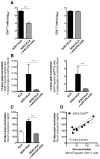The frequency of naive and early-activated hapten-specific B cell subsets dictates the efficacy of a therapeutic vaccine against prescription opioid abuse
- PMID: 25972483
- PMCID: PMC4458396
- DOI: 10.4049/jimmunol.1500385
The frequency of naive and early-activated hapten-specific B cell subsets dictates the efficacy of a therapeutic vaccine against prescription opioid abuse
Abstract
Translation of therapeutic vaccines for addiction, cancer, or other chronic noncommunicable diseases has been slow because only a small subset of immunized subjects achieved effective Ab levels. We hypothesize that individual variability in the number of naive and early-activated hapten-specific B cells determines postvaccination serum Ab levels and vaccine efficacy. Using a model vaccine against the highly abused prescription opioid oxycodone, the polyclonal B cell population specific for an oxycodone-based hapten (6OXY) was analyzed by flow cytometry paired with Ag-based magnetic enrichment. A higher frequency of 6OXY-specific B cells in either spleen biopsies or blood, before and after immunization, correlated to subsequent greater oxycodone-specific serum Ab titers and their efficacy in blocking oxycodone distribution to the brain and oxycodone-induced behavior in mice. The magnitude of 6OXY-specific B cell activation and vaccine efficacy was tightly correlated to the size of the CD4(+) T cell population. The frequency of enriched 6OXY-specific B cells was consistent across various mouse tissues. These data provide novel evidence that variations in the frequency of naive or early-activated vaccine-specific B and T cells can account for individual responses to vaccines and may predict the clinical efficacy of a therapeutic vaccine.
Copyright © 2015 by The American Association of Immunologists, Inc.
Figures







Similar articles
-
The frequency of early-activated hapten-specific B cell subsets predicts the efficacy of vaccines for nicotine dependence.Vaccine. 2015 Nov 17;33(46):6332-9. doi: 10.1016/j.vaccine.2015.09.015. Epub 2015 Sep 26. Vaccine. 2015. PMID: 26409811 Free PMC article.
-
Hapten-specific naïve B cells are biomarkers of vaccine efficacy against drugs of abuse.J Immunol Methods. 2014 Mar;405:74-86. doi: 10.1016/j.jim.2014.01.010. Epub 2014 Jan 23. J Immunol Methods. 2014. PMID: 24462800 Free PMC article.
-
Effect of currently approved carriers and adjuvants on the pre-clinical efficacy of a conjugate vaccine against oxycodone in mice and rats.PLoS One. 2014 May 5;9(5):e96547. doi: 10.1371/journal.pone.0096547. eCollection 2014. PLoS One. 2014. PMID: 24797666 Free PMC article.
-
Opioid-Based Haptens: Development of Immunotherapy.Int J Mol Sci. 2024 Jul 16;25(14):7781. doi: 10.3390/ijms25147781. Int J Mol Sci. 2024. PMID: 39063024 Free PMC article. Review.
-
[Novel vaccines against M. tuberculosis].Kekkaku. 2006 Dec;81(12):745-51. Kekkaku. 2006. PMID: 17240920 Review. Japanese.
Cited by
-
Preclinical Efficacy and Characterization of Candidate Vaccines for Treatment of Opioid Use Disorders Using Clinically Viable Carrier Proteins.Mol Pharm. 2018 Nov 5;15(11):4947-4962. doi: 10.1021/acs.molpharmaceut.8b00592. Epub 2018 Oct 10. Mol Pharm. 2018. PMID: 30240216 Free PMC article.
-
Opioid Dose- and Route-Dependent Efficacy of Oxycodone and Heroin Vaccines in Rats.J Pharmacol Exp Ther. 2018 May;365(2):346-353. doi: 10.1124/jpet.117.247049. Epub 2018 Mar 13. J Pharmacol Exp Ther. 2018. PMID: 29535156 Free PMC article.
-
Immunotherapeutic strategies for treating opioid use disorder and overdose.Expert Opin Investig Drugs. 2023 Jan;32(1):77-87. doi: 10.1080/13543784.2023.2173062. Epub 2023 Feb 12. Expert Opin Investig Drugs. 2023. PMID: 36696567 Free PMC article. Review.
-
The frequency of early-activated hapten-specific B cell subsets predicts the efficacy of vaccines for nicotine dependence.Vaccine. 2015 Nov 17;33(46):6332-9. doi: 10.1016/j.vaccine.2015.09.015. Epub 2015 Sep 26. Vaccine. 2015. PMID: 26409811 Free PMC article.
-
Monoclonal Antibodies Counteract Opioid-Induced Behavioral and Toxic Effects in Mice and Rats.J Pharmacol Exp Ther. 2020 Dec;375(3):469-477. doi: 10.1124/jpet.120.000124. Epub 2020 Sep 26. J Pharmacol Exp Ther. 2020. PMID: 32980813 Free PMC article.
References
Publication types
MeSH terms
Substances
Grants and funding
LinkOut - more resources
Full Text Sources
Other Literature Sources
Medical
Research Materials

